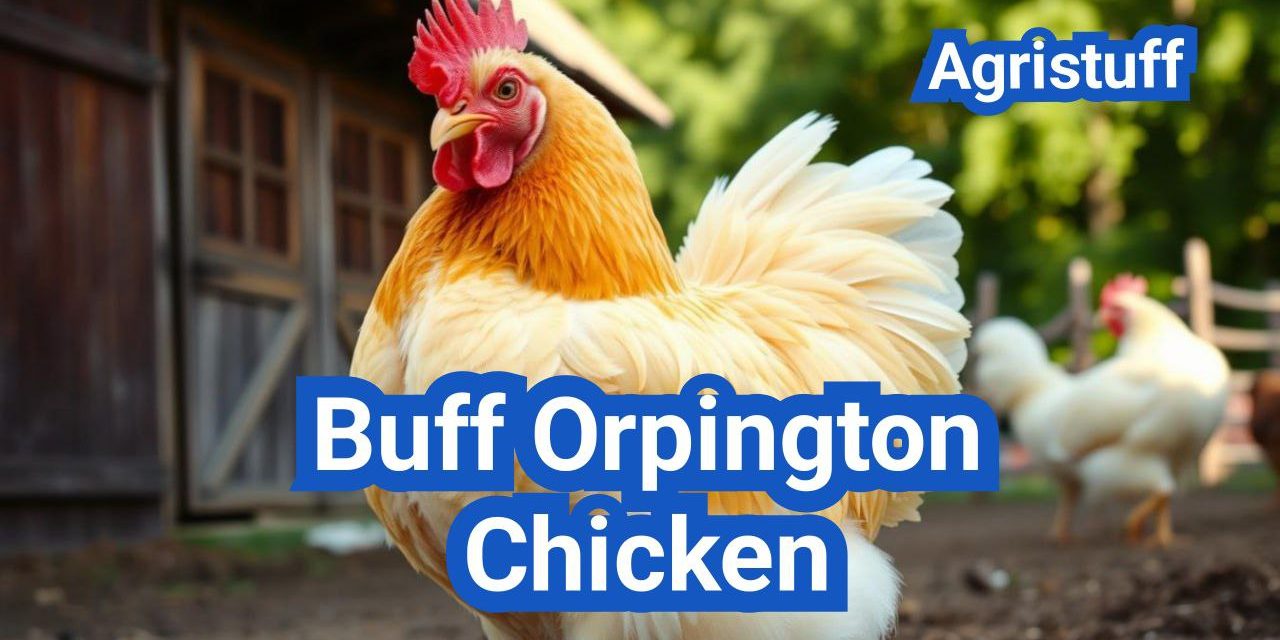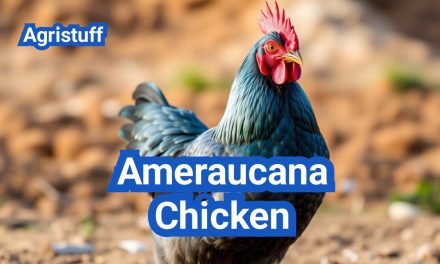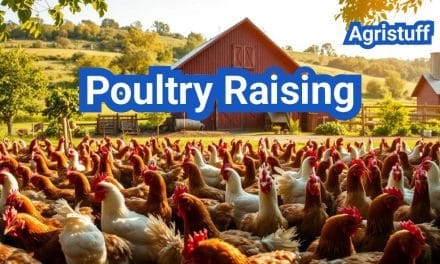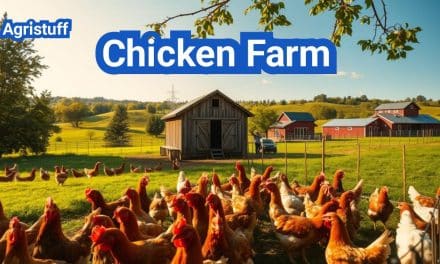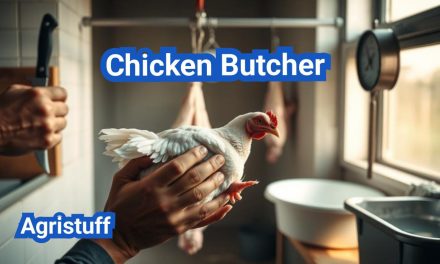The Buff Orpington Chicken is a beloved breed in America, cherished for its friendly temperament and impressive utility. Originating in Britain, this breed has become a staple in many backyard flocks due to its dual-purpose nature, providing both high-quality eggs and meat.
As a backyard chicken breed, the Buff Orpington is prized for its egg production, laying a significant number of Buff Orpington eggs throughout the year. Their friendly nature makes them an excellent choice for families and beginners in poultry keeping.
Key Takeaways
- The Buff Orpington is a dual-purpose breed suitable for eggs and meat.
- It is known for its friendly temperament, making it ideal for backyard flocks.
- The breed is recognized for its high egg production.
- Buff Orpingtons are a popular choice among backyard chicken keepers in America.
- They are relatively easy to care for, making them suitable for beginners.
The Charm of Buff Orpington Chickens
With their fluffy feathers and friendly demeanor, it’s no wonder Buff Orpingtons are a favorite among chicken enthusiasts. Their popularity stems from a combination of their docile nature and their utility as a dual-purpose breed, providing both high-quality eggs and meat.
Why They’re America’s Favorite
Buff Orpington chickens are renowned for their friendly temperament, making them an excellent choice for families with children. Their calm demeanor also makes them a great option for those new to backyard chicken keeping. The breed’s affectionate nature means they often seek out human interaction, further endearing them to their owners.
Their popularity is also due in part to their egg-laying abilities. Buff Orpingtons are consistent layers, producing a significant number of large, brown eggs throughout the year. This characteristic, combined with their friendly nature, makes them a top choice for many backyard chicken enthusiasts.
Dual-Purpose Benefits
One of the key advantages of Buff Orpingtons is their status as a dual-purpose breed. Not only do they provide a steady supply of eggs, but they are also raised for their high-quality meat. This dual utility makes them an attractive option for those looking to maximize the benefits of their backyard flock.
Raising Buff Orpingtons for both eggs and meat can be a rewarding experience, especially when done correctly. Ensuring that your flock is healthy and well-cared for is crucial, and this includes considerations for backyard chicken biosecurity. By maintaining a clean and secure coop, you can protect your Buff Orpingtons from disease and ensure they thrive.
For those interested in acquiring Buff Orpingtons, sourcing from NPIP certified hatcheries is a good practice. This certification ensures that the chickens are healthy and free from certain diseases, providing peace of mind for backyard chicken keepers.
History and Origins of the Buff Orpington

The story of the Buff Orpington begins with William Cook, an English breeder with a vision. In the late 19th century, Cook developed this iconic breed, which would later become a staple in American backyards. The Buff Orpington’s history is a tale of innovation, popularity, and the passion of poultry enthusiasts.
William Cook’s English Legacy
William Cook, an English poultry breeder, is credited with developing the Buff Orpington in the late 1800s. Cook’s breeding program aimed to create a dual-purpose chicken, exceling in both egg production and meat quality. His work in Orpington, Kent, England, led to the creation of a breed that was not only productive but also had a unique, appealing appearance.
The Buff Orpington quickly gained popularity in England due to its friendly nature, rich buff color, and excellent laying abilities. By the early 20th century, the breed had caught the attention of American poultry enthusiasts.
Journey to American Popularity
The Buff Orpington’s journey to America was marked by its introduction at poultry shows and its adoption by backyard farmers. The breed’s dual-purpose benefits and friendly disposition made it an instant hit among American chicken keepers.
As the breed gained popularity, it became a staple in many American farms and backyards. The Buff Orpington’s ability to thrive in various conditions and its consistent egg production solidified its place in American poultry keeping.
| Year | Event | Location |
|---|---|---|
| 1880s | William Cook begins breeding program | Orpington, Kent, England |
| Early 1900s | Buff Orpington introduced to America | United States |
| 1920s | Buff Orpington gains popularity in American poultry shows | United States |
Physical Characteristics of Buff Orpington Chicken Breeds
The Buff Orpington chicken breed is renowned for its impressive size and stunning appearance. These characteristics make them a standout among other chicken breeds.
Size and Weight Standards
Buff Orpingtons are considered a large breed. According to the American Poultry Association standards, males typically weigh around 10 pounds, while females weigh about 8 pounds. Their substantial size contributes to their popularity among backyard chicken keepers.
| Gender | Standard Weight |
|---|---|
| Male | 10 pounds |
| Female | 8 pounds |
Distinctive Appearance Features
One of the most distinctive features of Buff Orpingtons is their fluffy feathers and broad bodies. They have a rich, golden-buff plumage that is not only beautiful but also soft to the touch. Their feathers are fluffy and tend to make them appear even larger than they are.
Color Variations in Orpingtons
While Buff Orpingtons are known for their buff color, the Orpington breed as a whole comes in a variety of colors, including Lavender, Blue, and Black. The Buff color is a result of a specific genetic trait that gives them their characteristic golden-buff hue.
- Buff
- Lavender
- Blue
- Black
- Jubilee (a mix of black, white, and buff)
The variety of colors available in Orpingtons makes them appealing to a wide range of chicken enthusiasts, from those who prefer a uniform flock to those who enjoy a diverse and colorful backyard.
Buff Orpington Temperament and Behavior

One of the standout characteristics of Buff Orpington chickens is their incredibly docile temperament, which makes them an excellent choice for families. Their friendly and outgoing nature has endeared them to many backyard chicken enthusiasts across America.
Docile Nature and Family Friendliness
Buff Orpingtons are known for their calm and gentle disposition, making them an ideal breed for households with children. They are often described as having a sweet and affectionate nature, which contributes to their popularity as a family-friendly chicken breed.
- They are relatively easy-going and can adapt well to various living conditions.
- Their docile nature makes them less likely to engage in aggressive behavior.
- Buff Orpingtons are known to form strong bonds with their owners, often seeking human interaction.
Social Dynamics in the Flock
In terms of social dynamics, Buff Orpingtons generally integrate well into existing flocks, although introducing new birds should always be done with caution. They tend to establish a pecking order relatively quickly, and their calm nature helps to maintain harmony within the group.
Some key points about their social behavior include:
- They are generally not aggressive towards other breeds.
- Buff Orpingtons can be quite curious and enjoy exploring their surroundings.
- They tend to be good mothers if allowed to go broody, showing a strong maternal instinct.
Overall, the Buff Orpington’s friendly temperament and adaptable nature make them a wonderful addition to many backyard flocks, providing both companionship and productivity.
How to Set Up Housing for Buff Orpingtons
Setting up the right housing for your Buff Orpingtons is crucial for their health and happiness. Buff Orpingtons are known for their friendly nature and require spacious and well-designed housing to thrive.
Coop Size and Design Requirements
The coop is the heart of your chicken-keeping operation, providing a safe and comfortable space for your Buff Orpingtons to roost, lay eggs, and escape from predators. A well-designed coop should offer at least 3-4 square feet per bird inside the coop. The coop should be well-ventilated, dry, and draft-free.
When designing the coop, consider the following:
- Easy access for cleaning and egg collection
- Adequate ventilation to prevent ammonia buildup
- Protection from predators, including sturdy walls and a secure roof
- Nesting boxes, one per 3-4 hens, placed in a quiet, dark area
- Roosting bars, positioned higher than the nesting boxes
| Coop Size (sq ft) | Number of Hens | Nesting Boxes |
|---|---|---|
| 8-12 | 2-3 | 1-2 |
| 16-20 | 4-5 | 2-3 |
Run Space and Free-Range Considerations
In addition to a well-designed coop, Buff Orpingtons require adequate run space to exercise and engage in natural behaviors. The run should provide at least 8-10 square feet per bird. Fencing should be sturdy and at least 6 feet tall to prevent escape and predator entry.
Free-ranging can be beneficial, allowing chickens to forage for insects and plants. However, it’s essential to supervise to prevent losses to predators.
“Free-ranging can significantly enhance the welfare of chickens by providing them with a varied and stimulating environment.” –
Chicken Welfare Expert
Cold Weather Adaptations for This Hardy Breed
Buff Orpingtons are known for their cold hardiness, but they still require protection from extreme cold and wet conditions. Ensure the coop is well-insulated and draft-free. Additional measures include:
- Providing extra bedding during cold months
- Using a heated waterer to prevent freezing
- Ensuring adequate ventilation to prevent moisture buildup
By following these guidelines, you can create a comfortable and safe housing system for your Buff Orpingtons, ensuring their health and productivity throughout the year.
Complete Guide to Buff Orpington Egg Production
Buff Orpington chickens are renowned for their impressive egg-laying capabilities, making them a favorite among backyard poultry keepers. Their ability to produce a high volume of eggs, combined with their friendly nature, has cemented their place in many American backyards.
Egg Color and Size Expectations
Buff Orpingtons are known for laying large to jumbo-sized eggs, which are typically light brown in color. The eggs are not only a delight to collect but also a testament to the breed’s dual-purpose nature.
- Egg size: Large to jumbo
- Egg color: Light brown
- Annual production: Approximately 180-200 eggs per year
Production Rates and Seasonality
The egg production rate of Buff Orpingtons is influenced by factors such as nutrition, health, and environmental conditions. Generally, they are consistent layers, producing eggs throughout the year, with a slight decrease during the winter months.
Seasonal Variations:
- Peak production: Spring and early summer
- Reduced production: Winter months
How to Maximize Egg Yield
To maximize egg yield from your Buff Orpingtons, it’s essential to provide optimal care and nutrition. This includes:
- Ensuring access to a balanced diet rich in calcium and protein
- Maintaining a clean and stress-free environment
- Providing adequate lighting, especially during the shorter winter days
By following these guidelines, you can encourage your Buff Orpingtons to produce eggs at their full potential, making the most of their remarkable egg-laying abilities.
How to Raise Buff Orpington Chicks

The journey of raising Buff Orpington chicks begins with setting up the right brooder conditions. Buff Orpingtons are known for their friendly nature and beautiful golden feathers, making them a popular choice among backyard chicken keepers. To ensure these chicks grow into healthy adults, it’s crucial to provide them with proper care from the start.
Brooder Setup and Requirements
Setting up a brooder for Buff Orpington chicks involves creating a safe and warm environment. The brooder should be free from drafts and predators. A heat lamp or heat mat is necessary to maintain a temperature of around 95°F for the first week, gradually decreasing by 5°F each subsequent week until reaching 70°F.
Key components of a brooder setup include:
- A secure, escape-proof enclosure
- A heat source (heat lamp or heat mat)
- A thermometer to monitor temperature
- Bedding material (pine shavings or paper-based products)
- Feeders and waterers that are chick-accessible
Week-by-Week Development Guide
Buff Orpington chicks develop relatively slowly compared to other breeds. Here’s a week-by-week overview of what to expect:
Week 1-2: Chicks will be mostly dependent on the heat source. Ensure the brooder is clean, and monitor their weight and overall health.
Week 3-4: As they grow, you can start introducing them to outdoor areas under close supervision. Continue to decrease the brooder temperature as needed.
Week 5 and beyond: By this stage, the chicks should be fully feathered and can be moved to a coop or chicken house, provided it’s secure and draft-free.
By following these guidelines, you can successfully raise healthy Buff Orpington chicks. Remember, patience and consistent care are key to their development.
Feeding Your Buff Orpington Chickens Properly

The nutritional needs of Buff Orpington chickens vary by age, and understanding these needs is key to their health. Providing the right feed at different stages of their life ensures they grow strong and produce eggs consistently.
Nutritional Requirements by Age
Buff Orpington chickens have different nutritional requirements at various stages of their life. Chicks require a high-protein diet to support their rapid growth during the first few weeks. As they mature, their dietary needs shift towards maintaining overall health and supporting egg production.
For chicks, a starter feed with 20-22% protein is recommended. This high protein content supports their development. As they grow into pullets, the protein content can be gradually reduced to around 16-18%. For laying hens, a layer feed with 16% protein and added calcium is ideal for supporting eggshell production.
Recommended Feed Types and Supplements
Choosing the right feed type is crucial for the health of your Buff Orpington chickens. There are various feed types available, including pelleted feed, crumbles, and mash. Each has its benefits, and the choice often depends on the age and preferences of your chickens.
Supplements can also play a vital role in enhancing the nutritional value of their diet. Common supplements include grit for aiding digestion, oyster shells for providing calcium, and probiotics for supporting gut health. Ensuring access to fresh water at all times is also essential.
- Provide a balanced starter feed for chicks.
- Transition to a grower feed as they mature.
- Switch to a layer feed when they begin producing eggs.
- Consider adding supplements like grit and oyster shells.
Health Management and Lifespan

To ensure your Buff Orpingtons live a long and healthy life, understanding their health needs is essential. Buff Orpingtons are generally a hardy breed, but like all chickens, they require regular health checks and preventative care to thrive.
Expected Lifespan and Factors That Affect It
The average lifespan of a Buff Orpington chicken is between 8 to 12 years, depending on various factors such as diet, living conditions, and health management practices. Proper nutrition and a safe living environment are crucial for maximizing their lifespan.
| Factor | Impact on Lifespan |
|---|---|
| Diet | A balanced diet rich in nutrients supports overall health and longevity. |
| Living Conditions | A clean, safe coop and adequate space to roam contribute to a longer life. |
| Health Management | Regular health checks and preventative care practices help prevent diseases. |
Preventative Care Practices
Preventative care is key to maintaining the health of your Buff Orpingtons. This includes regular vaccinations, parasite control, and ensuring their living environment is clean and safe. Regular inspections of the flock can help identify health issues early, allowing for timely intervention.
- Regular vaccinations against common poultry diseases
- Parasite control measures, including treatments for mites and lice
- Maintaining a clean coop and run
Recognizing and Treating Common Ailments
Despite best care practices, Buff Orpingtons can still be susceptible to certain health issues. Common ailments include respiratory infections, parasites, and reproductive issues. Early detection and appropriate treatment are critical for recovery. Familiarize yourself with the signs of illness, such as changes in behavior, appetite, or droppings.
How to Manage Broody Behavior in Buff Orpingtons

Buff Orpington chickens are known for their tendency to go broody, a trait that can be both beneficial and challenging for backyard chicken keepers. Broodiness is a natural behavior where a hen stops laying eggs and becomes dedicated to incubating eggs or even just sitting on a nest.
Signs of Broodiness
Identifying broodiness early is crucial for managing it effectively. Signs include:
- A hen staying on the nest for extended periods
- Reduced or completely stopped egg production
- Increased aggression or defensiveness when approached
- Fluffed feathers and a generally more assertive demeanor
According to expert chicken keepers, “A broody hen is a determined hen. She will sit tight, even when faced with predators or other disturbances.”
“The broody hen is a marvel of nature, dedicated to her task with a fierce devotion.”
Effective Methods for Breaking a Broody Hen
Breaking a broody hen involves discouraging her from sitting on the nest. Methods include:
| Method | Description | Effectiveness |
|---|---|---|
| Cooling | Removing the hen from the nest and placing her in a cooler area | High |
| Isolation | Separating the hen from the rest of the flock | Medium |
| Increasing Activity | Encouraging foraging and exercise | High |
It’s essential to be patient and consistent when trying to break a broody hen. Some hens may require multiple attempts before they return to normal laying behavior.
Using Broodiness to Your Advantage
Broodiness can be utilized for natural incubation of eggs. If you have a broody Buff Orpington, you can place fertile eggs under her, allowing her to hatch them naturally.
This natural method can be an effective way to expand your flock or breed new chickens. However, it requires careful monitoring to ensure the health and well-being of both the hen and the chicks.
Raising Buff Orpingtons as Meat Birds

While often kept for eggs, Buff Orpingtons can be raised effectively as meat birds, offering a dual-purpose solution for backyard farmers. This versatility makes them an attractive choice for those looking to manage a sustainable and diverse farm.
Growth Rates and Optimal Processing Age
Buff Orpingtons have a relatively slow growth rate compared to specialized meat breeds. However, they can still be processed at a relatively young age. Here are some key points to consider:
- Growth Rate: Buff Orpingtons take longer to mature than commercial broiler breeds.
- Optimal Processing Age: Typically, they are processed between 16 to 20 weeks of age.
- Weight at Processing: Males can weigh around 8-10 lbs, while females weigh about 6-8 lbs.
Meat Quality and Yield
The meat quality of Buff Orpingtons is known for being tender and flavorful. Key aspects include:
- Meat Tenderness: The meat is generally tender, making it suitable for various cooking methods.
- Flavor Profile: Buff Orpington meat is often described as having a rich, chicken-like flavor.
- Dressing Percentage: The dressing percentage is relatively high, indicating a good yield of usable meat.
In conclusion, raising Buff Orpingtons for meat can be a rewarding experience, offering a unique combination of growth rate, meat quality, and yield. By understanding these factors, farmers can make informed decisions about incorporating Buff Orpingtons into their meat production plans.
Comparing Buff Orpingtons to Other Orpington Varieties

Orpington chickens come in a range of colors, including Buff, Lavender, and Blue, each with distinct features. While Buff Orpingtons are renowned for their friendly nature and rich golden color, other varieties offer unique characteristics that may suit different preferences or needs.
Lavender Orpingtons
Lavender Orpingtons are known for their soft, pale lavender plumage. They share many characteristics with Buff Orpingtons, including a friendly temperament and good egg-laying abilities. However, their unique color makes them stand out in any flock.
Blue Orpingtons
Blue Orpingtons have a striking blue-gray color that is both beautiful and distinctive. Like other Orpingtons, they are known for their docile nature and are suitable for families with children. Their egg production is similar to that of Buff Orpingtons, making them a good choice for those looking for a steady supply of eggs.
Jubilee Orpingtons
Jubilee Orpingtons are characterized by their multi-colored plumage, featuring a mix of black, white, and gold. They are friendly, hardy, and known for their good foraging abilities. Jubilee Orpingtons are also good egg layers and are often praised for their unique appearance.
Black and Other Orpington Colors
Black Orpingtons, along with other less common colors like White and Red, offer further variety within the Orpington breed. Each color variation has its own charm, and while they may share many characteristics with Buff Orpingtons, their differences in appearance can add diversity to a flock.
In summary, while Buff Orpingtons are a popular choice, other Orpington varieties offer a range of colors and characteristics that can enhance any backyard flock. Whether you’re drawn to the soft hue of Lavender Orpingtons or the striking color of Blue Orpingtons, there’s an Orpington variety to suit every taste.
- Lavender Orpingtons: Soft lavender color, friendly, good egg layers
- Blue Orpingtons: Blue-gray color, docile, steady egg production
- Jubilee Orpingtons: Multi-colored, friendly, good foragers, good egg layers
- Black Orpingtons: Solid black color, shares many characteristics with other Orpingtons
How to Purchase Quality Buff Orpingtons
To ensure you’re getting the best Buff Orpingtons, follow these guidelines for a successful purchase. Buying quality chickens involves more than just selecting a breed; it requires understanding the health, quality, and characteristics of the birds you’re purchasing.
Finding NPIP Certified Hatcheries
One of the first steps in purchasing quality Buff Orpingtons is to find a reputable source. Look for NPIP certified hatcheries, which are recognized for their high standards in poultry health. NPIP certification ensures that the hatchery follows strict guidelines to prevent the spread of diseases such as Salmonella and Mycoplasma.
- Research local and online hatcheries that are NPIP certified.
- Check for reviews and testimonials from other customers.
- Ask about their health guarantees and vaccination practices.
What to Look for in Chicks and Adult Birds
When evaluating Buff Orpington chicks or adult birds, there are several factors to consider:
- Health: Look for birds that are active and alert. Check for any signs of illness or injury.
- Conformation: Ensure the birds conform to the breed standard for Buff Orpingtons.
- Temperament: Buff Orpingtons are known for their friendly nature, so observe how the birds interact with you and each other.
Average Prices and Value Considerations
The price of Buff Orpingtons can vary based on factors like location, breeder reputation, and the quality of the birds. On average, you can expect to pay between $3 to $5 per chick, while adult birds may cost more. Consider the value you’re getting for your money by evaluating the health, breed quality, and any guarantees provided by the seller.
When purchasing Buff Orpingtons, it’s not just about the initial cost; it’s about the long-term value they bring to your flock. Quality birds are more likely to be healthy, productive, and friendly, making them a worthwhile investment.
Implementing Backyard Biosecurity for Your Flock
As a backyard chicken keeper, implementing effective biosecurity measures is essential for the well-being of your Buff Orpingtons. Biosecurity refers to the practices and procedures put in place to prevent the introduction and spread of diseases within your flock.
Essential Biosecurity Practices
To maintain a healthy flock, several key biosecurity practices should be adopted. These include:
- Restricting Access: Limiting who can enter your coop and run can significantly reduce the risk of disease transmission.
- Cleaning and Disinfection: Regularly cleaning and disinfecting the coop, equipment, and any other items that come into contact with your chickens is crucial.
- Proper Disposal of Dead Birds: Ensuring that dead birds are disposed of promptly and properly can prevent the spread of disease.
- Monitoring Flock Health: Regularly checking your chickens for signs of illness allows for early detection and intervention.
Protecting Your Buff Orpingtons from Disease
Buff Orpingtons, like all chicken breeds, are susceptible to various diseases. Implementing biosecurity measures can protect them from common poultry diseases.
| Disease | Symptoms | Prevention Measures |
|---|---|---|
| Avian Influenza | Respiratory issues, lethargy, sudden death | Keep wild birds away, disinfect equipment |
| Newcastle Disease | Respiratory distress, neurological signs | Vaccination, strict biosecurity |
| Coccidiosis | Diarrhea, weight loss, lethargy | Cleanliness, anticoccidial medication |
By understanding and implementing these biosecurity practices, you can significantly reduce the risk of disease in your Buff Orpington flock, ensuring they remain healthy and productive.
Why Buff Orpingtons Remain a Top Choice
Buff Orpington chickens have earned their place as America’s favorite dual-purpose breed due to their numerous benefits. Their friendly and docile nature makes them an excellent choice for backyard flocks, especially for families with children.
The benefits of Buff Orpington chickens include high egg production, with hens laying around 200-220 brown eggs per year. Additionally, they provide quality meat, making them a great option for those looking to raise chickens for both eggs and meat.
So, why choose Buff Orpingtons? Their versatility, gentle disposition, and impressive production capabilities make them a top choice among backyard chicken enthusiasts. Whether you’re a seasoned poultry keeper or just starting out, Buff Orpingtons are an excellent addition to any flock.
FAQ
What is the average lifespan of a Buff Orpington chicken?
The average lifespan of a Buff Orpington chicken is 8-12 years, depending on factors such as diet, health conditions, and living environment.
How many eggs can I expect from a Buff Orpington hen per year?
Buff Orpington hens are known for their impressive egg production, laying around 180-200 large, brown eggs per year.
Are Buff Orpingtons good with children and other pets?
Yes, Buff Orpingtons are renowned for their friendly, docile nature, making them an excellent choice for families with children and other pets.
What are the ideal coop and run requirements for Buff Orpingtons?
Buff Orpingtons require a coop with adequate ventilation and a run that provides enough space to move around comfortably, with a minimum of 4-5 square feet per bird inside the coop and 8-10 square feet per bird in the run.
How do I manage broody behavior in Buff Orpington hens?
To manage broody behavior, it’s essential to identify the signs of broodiness, remove eggs from the nesting box, and provide a cool, well-ventilated area to help the hen break her broodiness.
Can Buff Orpingtons be raised for meat, and what are their growth rates?
Yes, Buff Orpingtons can be raised for meat, and they are known for their fast growth rates, reaching optimal processing age in about 16-20 weeks.
How do I feed my Buff Orpingtons to ensure optimal health?
Buff Orpingtons require a balanced diet that includes a mix of grains, proteins, and vitamins, with layer feed recommended for hens and starter feed for chicks.
What are the most common health issues in Buff Orpingtons, and how can I prevent them?
Common health issues in Buff Orpingtons include respiratory problems, parasites, and reproductive issues; preventative measures include providing a clean living environment, regular health checks, and vaccinations.
Where can I find NPIP certified hatcheries to purchase quality Buff Orpingtons?
You can find NPIP certified hatcheries through online directories or by contacting local poultry associations, ensuring that you’re purchasing healthy, disease-free birds.
What are the essential biosecurity practices for protecting my Buff Orpington flock?
Essential biosecurity practices include restricting access to your flock, using disinfectants, and monitoring for signs of disease, helping to protect your Buff Orpingtons from illness.
How do Buff Orpingtons compare to other Orpington varieties?
Buff Orpingtons are one of several Orpington varieties, with differences in plumage color, including Lavender, Blue, and Jubilee Orpingtons, each with their unique characteristics.
Conclusion of: Buff Orpington Chicken
Why the Buff Orpington Chicken belongs on American homesteads
The Buff Orpington Chicken has earned a loyal following across the U.S. for one big reason: it does nearly everything well. Calm, hardy, family-friendly, and productive for both eggs and meat, the Buff Orpington Chicken is a quintessential dual-purpose bird that fits backyard coops and small farms alike. If you’re building a flock that’s easy to manage yet still efficient, the Buff Orpington Chicken deserves a top spot on your list. Oklahoma State University – Orpington Chickens
Quick definition: What is a Buff Orpington Chicken?
At its core, a Buff Orpington Chicken is the buff-colored variety of the British Orpington breed—big, soft-feathered birds created in England as a true dual-purpose breed. Within the overall Orpington family, the Buff Orpington Chicken is the most popular color variety in U.S. backyards thanks to its dependable egg laying and excellent table qualities. The Livestock Conservancy – Orpington Chicken
Origins: The 1880s vision that produced the Buff Orpington Chicken
The story of the Buff Orpington Chicken begins with William Cook of Orpington, Kent. In the late 19th century he crossed Minorca, Black Plymouth Rock, and clean-legged Langshan to produce a practical, fast-growing, good-laying bird. After launching the Black Orpington in 1886, Cook and contemporaries developed additional colors, with the Buff Orpington Chicken first publicly exhibited in 1894 and quickly embraced by utility and exhibition breeders alike. Poultry Club of Great Britain – Orpington (history & dates)
Arrival and acceptance in America
As Orpingtons spread beyond Britain, the Buff Orpington Chicken became a farmer favorite in the American Midwest for its table qualities and attractive buff plumage. In the U.S., the American Poultry Association recognized Orpingtons in multiple varieties, with the Buff Orpington Chicken admitted in 1902, solidifying its status as a standardbred dual-purpose bird for American flocks. The Livestock Conservancy – APA recognition timeline
Breed standard: Size, comb, and the signature buff color
A mature Buff Orpington Chicken is a large, deep-bodied bird with abundant, soft feathering. Standard weights commonly cited in the U.S. are around 10 lb for cocks and 8 lb for hens, with white skin and brown eggs. In the U.S. standard, the Buff Orpington Chicken is recognized with a single comb; rose combs exist in the global Orpington family but aren’t APA-recognized for Buffs. OSU Breeds of Livestock – Orpington characteristics & weights | Lafeber (vet resource) – comb & variety overview
Temperament: Why the Buff Orpington Chicken is great with families
Known for a calm, gentle personality, the Buff Orpington Chicken is easy to handle around children and new keepers. Their docility makes routine care—like health checks, nail trims, or moving birds between pens—straightforward. One note: because they’re mellow, a Buff Orpington Chicken can sometimes be bullied by more assertive breeds, so mixed flocks should be observed to keep the peace. OSU – temperament & management notes
Egg performance: What to expect from a Buff Orpington Chicken
As layers, a Buff Orpington Chicken typically produces about 200–280 brown eggs per year under good management, with peak output in the first two years. That’s roughly 4–5 eggs per week in season. Like other breeds, production dips during molt and when daylight shortens unless you provide supplemental light to maintain 14–16 hours/day. UNH Extension – yearly egg estimates & lighting
Meat qualities: A classic dual-purpose bird
With solid frame and good muscle, the Buff Orpington Chicken dresses out nicely as a table bird. Historically, Orpingtons were prized for broilers and roasters, and a Buff Orpington Chicken still delivers flavorful meat for homestead freezers while continuing to lay consistently during its prime seasons. The Livestock Conservancy – dual-purpose use
Broodiness and mothering: Natural hatching with a Buff Orpington Chicken
If you enjoy hatching your own chicks, the Buff Orpington Chicken is a strong candidate. Hens are known to go broody and sit diligently, often proving to be excellent mothers. For keepers who prefer constant egg output, simply collect eggs promptly and break broody cycles to keep a Buff Orpington Chicken focused on laying. OSU – broodiness & maternal behavior
Climate readiness: Why a Buff Orpington Chicken shines in cold regions
The heavy feathering of a Buff Orpington Chicken helps it tolerate cold climates well, making it a smart pick for northern states. While all chickens need dry, draft-free housing, many keepers choose Buff Orpingtons specifically for winter hardiness and steady production in cooler conditions. UConn Extension – cold-hardy breeds include Buff Orpingtons
Coop & space: Setting up housing for your Buff Orpington Chicken
A large-bodied Buff Orpington Chicken appreciates elbow room. Plan for a ventilated, dry coop with roughly 2–4 square feet per bird inside plus an outdoor run, secure roosts, and easy-to-access nest boxes. Secure with hardware cloth, not chicken wire, and lock doors at night to keep predators out. UConn Extension – housing & predator protection basics
Nesting, lighting & laying rhythm for a Buff Orpington Chicken
Provide one nest box per 4–5 hens so each Buff Orpington Chicken can lay without crowding. Because day length drives egg hormones, expect production to slow in fall unless you offer 14–16 hours of light daily. During molt, your Buff Orpington Chicken will pause laying while replacing feathers. University of Minnesota Extension – egg production & lighting
Feeding for performance: What a Buff Orpington Chicken needs
Once pullets approach lay, switch your Buff Orpington Chicken to a complete layer feed (about 16% protein) with extra calcium for shell strength. Most hens consume around a quarter-pound of feed daily; keep clean water available at all times and offer oyster shell free-choice if needed for shell quality. Oregon State University – feeding laying hens
How much feed? Budgeting for a Buff Orpington Chicken
To plan costs, assume each Buff Orpington Chicken will eat roughly 0.25 lb of feed per day (about 100–150 g). A 50-lb bag lasts around 20 days for ten hens, fluctuating with weather and activity. Keep feed protected from rodents and moisture to maintain quality. Alabama Cooperative Extension – daily feed intake
Biosecurity: Keeping your Buff Orpington Chicken healthy
Even hardy breeds like the Buff Orpington Chicken need strong biosecurity. Separate your flock from wild birds, quarantine newcomers for at least two weeks, and clean tools and boots before entering the coop. USDA’s Defend the Flock program offers practical checklists and posters you can print and keep in the barn. USDA APHIS – Defend the Flock
Avian influenza: Practical precautions for your Buff Orpington Chicken
Highly pathogenic avian influenza remains a reality in North America. While risk to the general public is low, a backyard Buff Orpington Chicken flock can be exposed via wild birds. Limit contact with waterfowl, keep feed covered, and report sudden illness or mortalities to your state vet. CDC – Guidance for backyard flock owners
Buying chicks & hatching eggs: Choose NPIP-certified sources
When sourcing a Buff Orpington Chicken, look for hatcheries and breeders participating in the National Poultry Improvement Plan (NPIP). NPIP is a cooperative federal-state program that monitors flocks for key diseases, helping you start with healthier stock. Ask suppliers for their NPIP number and disease testing status. USDA APHIS – What is NPIP?
Managing broodiness: Balancing eggs and chicks with a Buff Orpington Chicken
A broody Buff Orpington Chicken will sit, stop laying, and focus on hatching. If your goal is eggs, break the cycle by removing eggs promptly, increasing ventilation under the hen, or using a wire-bottomed crate for a short “cool-down” period. If your goal is chicks, provide a quiet, predator-proof broody pen for safe hatching. OSU – broodiness tendencies
Buff vs. other Orpington colors: What makes the Buff Orpington Chicken stand out
Although Orpingtons come in several varieties, the Buff Orpington Chicken remains the most recognized in American backyards for its classic golden plumage and steady production. Historically, Buffs surged in popularity for both exhibition and utility, and they continue to represent the breed in many U.S. flocks. Poultry Club of Great Britain – color varieties & background
Mixing breeds: Coop dynamics with a Buff Orpington Chicken
In mixed flocks, a Buff Orpington Chicken usually gets along with others—but watch for dominant birds that may crowd them off feeders. Provide multiple feeding stations and ample perch space to prevent pecking-order stress so your Buff Orpington Chicken maintains condition and keeps laying. Lafeber – temperament notes
Winter management: Keep a Buff Orpington Chicken laying in the cold
Because the Buff Orpington Chicken tolerates cold well, simple steps go a long way—dry litter, good ventilation without drafts, and adequate daylight (14–16 hours) to support winter laying. Avoid overheating the coop; instead, focus on dryness, airflow above roost height, and windbreaks. UMN Extension – lighting & seasonal production
Brooder to layer: A timeline for your Buff Orpington Chicken
Expect your Buff Orpington Chicken pullets to start laying around 5.5–6.5 months if they reach target weight on a balanced ration. Feed a chick starter, then a grower until ~18–20 weeks, then transition to layer feed as the first eggs appear. Keep water clean and accessible at all times. OSU (PNW-477) – when to start layer feed
Is the Buff Orpington Chicken still a conservation priority?
Thanks to wide adoption in the U.S., the Buff Orpington Chicken helped the Orpington breed overall “graduate” off The Livestock Conservancy’s Priority List in 2016. That success story stems from practical utility and sustained interest from homesteaders and hobby breeders. The Livestock Conservancy – Graduated 2016
Checklist: Choosing your first Buff Orpington Chicken
Before ordering a Buff Orpington Chicken, confirm local ordinances, line up NPIP-certified sources, plan a draft-free coop with secure run, and budget feed at about 0.25 lb per hen per day. Add predator-proofing (hardware cloth, locks), then quarantine any new birds for two weeks before integrating. USDA Defend the Flock – printable biosecurity tools
Final thought
Whether you keep three birds or thirty, the Buff Orpington Chicken offers a rare mix of productivity and personality. For families, schools, and small farms that want reliable eggs, a solid carcass, and low-stress handling, the Buff Orpington Chicken remains a standout dual-purpose choice in American backyards. OSU – Orpington overview
Sources & References
- Oklahoma State University – Orpington Chickens (breed origin, weights, traits)
- The Livestock Conservancy – Orpington Chicken (history, APA dates, conservation status)
- Poultry Club of Great Britain – Orpington (history & dates)
- University of New Hampshire Extension – Egg Production Estimates & Lighting
- University of Minnesota Extension – Egg production, lighting, management
- Oregon State University (PNW-477) – Feeding Laying Hens
- Alabama Cooperative Extension – Feed Intake per Hen
- UConn Extension – Cold-hardy breeds & housing basics
- USDA APHIS – Defend the Flock (biosecurity)
- CDC – Backyard Flock Owner Guidance (avian influenza)
- Lafeber (Veterinary resource) – Comb recognition & temperament

